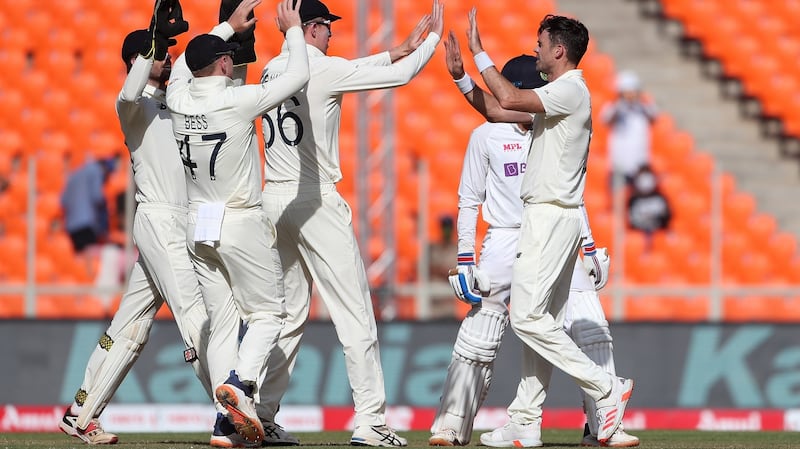Fourth Test day one: India 24-1 off 12 overs (J Anderson 1-0) trail England 205 (B Stokes 55, A Patel 4-68) by 181 runs with nine wickets remaining.
Another day, another dolour. After eight weeks and six days on tour, this weary, wounded, England team staggered into the sixth, and last, Test of the winter. The good news is they won the toss, and cobbled together their highest score since their first innings of the series, the bad that it was still only 205. And if they could point to improvements in the way some of the batsmen went about their work, it was undeniable, too, that some of their failings felt pretty familiar. A little bad luck, a couple of technical flaws, a lot of confused thinking, all added up to an underwhelming total and the unavoidable sense that their limitations had been exposed by a good attack on a tricky pitch.
By stumps, India were 24 for one, so 181 runs behind, and it was hard to avoid the feeling that, fight as they might – Jimmy Anderson bowled five maidens in a row – England’s jury-rigged, four-man bowling attack were already up against it. The team selection felt a little desperate, the all-in thinking of a man holding a losing hand in the small hours. It brought Dan Lawrence back to bat at No 7, and left England with a four-man attack, one of them, Dom Bess, only just dropped, and another Ben Stokes, who had only bowled 15 overs all tour and was suffering with a stomach bug. It turned out that Jofra Archer was unavailable for selection because his elbow problem had flared up again, which feels foreboding too.
India, on the other hand, simply swapped around two of their seamers, replacing Jasprit Bumrah with Mohammed Siraj, who bowled so well, with such waspish pace and swing, that they were arguably stronger for it.
You could feel England’s weariness, see it in the twitchiness of the openers when Virat Kohli brought Axar Patel into the attack after five overs of the innings. Patel duly dismissed them both in his first two overs. Sibley was bowled off the inside edge (he walked off muttering to himself under his breath, all that talk, all those thoughts, all that time working out how to go about it, and he’d done gone missed a straight one) while Crawley was caught at mid-on as he came skipping down the pitch to try and hit the ball down the ground. Crawley had done something similar to four of the five previous balls, so Patel saw him coming.

When Siraj got Root lbw with the first ball after a drinks break, England were 30 for three, and on the verge of another collapse. Root’s form on this tour has run in inverse proportion to the cares of captaincy. Which speaks, among other things, to the lack of support he’s had from his senior teammates. Two of them, Jonny Bairstow and Ben Stokes, tried to make amends now, and they did steer England away from the brink. Stokes was batting with gritted-teeth, doubly determined after Kohli made a point of picking a row with him because he swapped words with Siraj after fencing at a short ball. A flurry of fours followed, some off the edge of the bat, others off its middle, as well as one glorious six over long-on off the second ball he faced from Ravichandran Ashwin.
Stokes’ confidence seemed to rub off on Bairstow, who was just beginning to rediscover some of the touch he showed in Sri Lanka when Siraj got him for 28 with a very similar sort of delivery to the one that did for Root (it was given out lbw on review, as an umpire’s call on height, which was odd, since the umpire himself seemed to think Bairstow had been caught behind when he made the decision). And that dismissal turned out to be the one that told the story of England’s innings. Bairstow had faced 67 balls, so had got himself in, but wasn’t able to go on to play the match-defining innings the team needed. Stokes, Ollie Pope and Lawrence all did likewise.
Stokes went for 55, a fine innings while it lasted, which turned into a duel with India’s third spinner, Washington Sundar, who beat him repeatedly on the outside edge, and dismissed him, in the end, with one that went straight on past a tired looking defensive shot.
Pope played better than he had all tour, he used his feet to come down the pitch and his bat to smother the spin. Lawrence, granted the freedom of batting at No 7, was looser, and played more shots. Their 45-run partnership gave a little glimpse of the future of English batting, and, while it lasted, it all looked pretty handsome. But Pope was done by a bit of bad luck when the ball ricocheted off his inside edge between his legs onto his back calf and looped up to be caught at short leg, and Lawrence by a bit of bad judgement, as he threw a yahoo drive at Patel and was stumped trying to hit a boundary to bring up his fifty. Foakes, who’d batted so stubbornly in the last two Tests, was worked over by Ashwin. He and Bess, batting down at No 9, only added four runs between them.
In the end it will go down as a litany of missed opportunities, much, you guess, like the series itself. - Guardian












